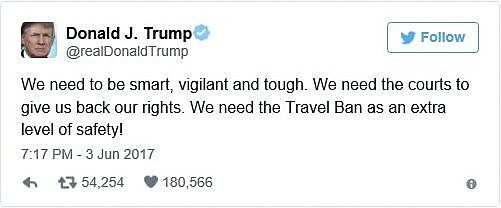Free society came under attack twice this month, first when Islamists rammed a van into pedestrians and went on a knife-slashing rampage in the Southwark district of London, and then when a gunman opened fire on Republican lawmakers in the Del Ray neighborhood of Northern Virginia.
In both cases, police had barely begun their investigations when an American politician—first the Republican president, then a Democratic governor—seized on the carnage to advocate political causes via electronic media.
In the hours after the London attack, President Trump took to Twitter to push his administration’s proposed travel ban on people from several predominantly Muslim countries:
Then, in the first police briefing on the Del Ray shooting, Virginia Gov. Terry McAuliffe called for expanded gun control:
It’s reasonable for a politician to advocate policies that he thinks will reduce future recurrences of a fresh tragedy. However, Trump’s immigration proposals are supported by people who typically oppose McAuliffe’s gun control proposals, and McAuliffe’s are supported by people who typically oppose Trump’s. This is puzzling because the proposals themselves are remarkably similar: they would constrain individuals’ freedoms in an effort to improve public safety. So why do the two proposals get such different responses from different people?
It’s not that there’s a big difference in the risk to public safety posed by immigrants or guns. Both have proven to be harmful, in the sense that both immigrants and guns have caused violence. But the risk posed by the typical gun or immigrant is tiny.
In the United States, there are roughly 11,000 gun homicides a year, 22,000 other gun deaths (largely suicides), and perhaps 75,000 other gun injuries. Those numbers are grisly, but assuming that a different gun is used in each incident (an extremely conservative, false assumption), the sum of those numbers is dwarfed by the estimated 300 million guns in the United States. Less than 0.04% of guns are involved in one of those incidents each year.
The risk posed by immigrants is also tiny. As Michelangelo Landgrave and Alex Nowrasteh have noted, less than 1% of illegal immigrants (about 123,000 people) and less than 0.5% of legal immigrants (roughly 64,000 people) in the United States were incarcerated in a given year for the commission of any sort of crime (compared to about 1.5% of natives, some 2 million people). Concerning terrorism specifically, the numbers are unimaginably small; Alex calculates that 0.0006% of refugees and 0.00004% of illegals who have entered the United States in the last few decades have committed a domestic act of terror or were convicted of planning one.
Reasonable efforts to reduce dangerous persons’ legal access to guns and to bar entry for dangerous would-be immigrants are sensible. Some such controls are permitted under the U.S. Constitution and American law, though they generally protect the right to keep and bear arms (especially for protection) and prohibit discrimination on the basis of religion (though, it should be acknowledged, there’s no constitutional right to immigrate). But, constitutional concerns aside, the risk numbers hardly support broad travel bans, “extreme vetting,” or “gun controls” that—speaking empirically—don’t appear to enhance public safety.
Beyond constitutionally protected rights, any policy to control guns or immigration should recognize the benefits they provide. Guns offer protection and recreation for millions of Americans. Estimates of the number of crimes thwarted each year by firearms in the United States range between the tens of thousands and millions. Meanwhile, each new wave of immigrants provides the country with more workers, more entrepreneurs, more consumers, and more contributors to the nation’s social fabric.
As a libertarian, I highly value those benefits and freedoms. Given my priors and the numbers mentioned above, I’m skeptical of calls for tighter controls on either immigration or legal gun ownership. But, putting those priors aside, I’m puzzled by the selective risk-intolerance of Trump, McAuliffe, and their supporters.
Why are Trump and so many red-teamers willing to adopt restrictions to curb the tiny risks posed by immigrants, but aren’t willing to do so for the similarly tiny risks posed by guns? Conversely, why are McAuliffe and blue-teamers willing to restrict guns but not immigration? Shouldn’t their risk sensitivities for either be the same?
And, if you agree with me that they should be, then what is this red/blue fight over guns and immigration really about?

